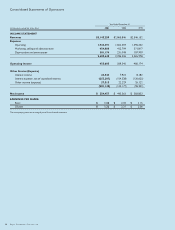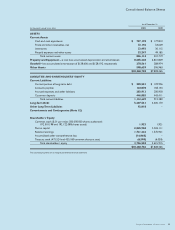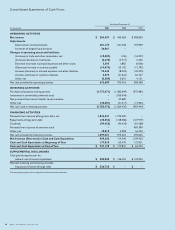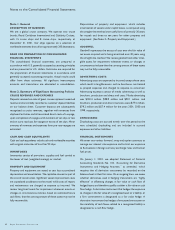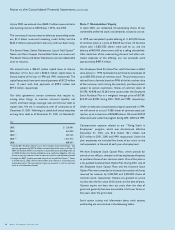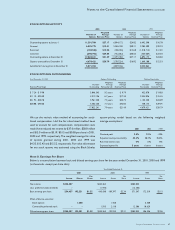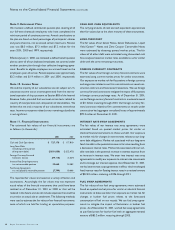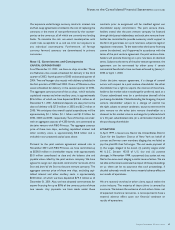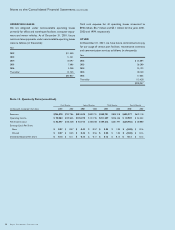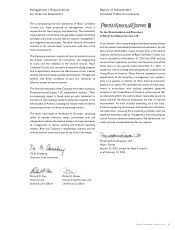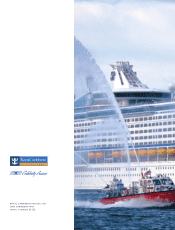Royal Caribbean Cruise Lines 2001 Annual Report Download - page 50
Download and view the complete annual report
Please find page 50 of the 2001 Royal Caribbean Cruise Lines annual report below. You can navigate through the pages in the report by either clicking on the pages listed below, or by using the keyword search tool below to find specific information within the annual report.
Notes to the Consolidated Financial Statements (continued)
48 Royal Caribbean Cruises Ltd.
Note 9. Retirement Plans
We maintain a defined contribution pension plan covering all of
our full-time shoreside employees who have completed the
minimum period of continuous service. Annual contributions to
the plan are based on fixed percentages of participants’ salaries
and years of service, not to exceed certain maximums. Pension
cost was $8.3 million, $7.3 million and $7.2 million for the
years 2001, 2000 and 1999, respectively.
Effective January 1, 2000, we instituted a defined benefit pension
plan to cover all of our shipboard employees not covered under
another pension plan through their collective bargaining agree-
ment. Benefits to eligible employees are accrued based on the
employee’s years of service. Pension expense was approximately
$3.2 million and $1.9 million in 2001 and 2000, respectively.
Note 10. Income Taxes
We and the majority of our subsidiaries are not subject to U.S.
corporate income tax on income generated from the interna-
tional operation of ships pursuant to Section 883 of the Internal
Revenue Code, provided that we meet certain tests related to
country of incorporation and composition of shareholders. We
believe that we and a majority of our subsidiaries meet these
tests. Income tax expense related to our remaining subsidiaries
is not significant.
Note 11. Financial Instruments
The estimated fair values of our financial instruments are
as follows (in thousands):
2001 2000
Cash and Cash Equivalents $ 727,178 $ 177,810
Long-Term Debt
(including current portion
of long-term debt) (5,031,858) (3,332,475)
Foreign Currency Forward
Contracts (losses) (99,110) (5,624)
Interest Rate Swap Agreements
in a net receivable position 35,668 24,583
Fuel Swap Agreements
in a net (payable) receivable position (7,799) 10,666
The reported fair values are based on a variety of factors and
assumptions. Accordingly, the fair values may not represent
actual values of the financial instruments that could have been
realized as of December 31, 2001 or 2000 or that will be
realized in the future and do not include expenses that could be
incurred in an actual sale or settlement. The following methods
were used to estimate the fair values of our financial instruments,
none of which are held for trading or speculative purposes:
CASH AND CASH EQUIVALENTS
The carrying amounts of cash and cash equivalents approximate
their fair values due to the short maturity of these instruments.
LONG-TERM DEBT
The fair values of our Senior Notes, Senior Debentures, Liquid
Yield Option™ Notes and Zero Coupon Convertible Notes
were estimated by obtaining quoted market prices. The fair
values of all other debt were estimated using discounted cash
flow analyses based on market rates available to us for similar
debt with the same remaining maturities.
FOREIGN CURRENCY CONTRACTS
The fair values of our foreign currency forward contracts were
estimated using current market prices for similar instruments.
Our exposure to market risk for fluctuations in foreign currency
exchange rates relates to our firm commitments on vessel con-
struction contracts and forecasted transactions. We use foreign
currency forward contracts to mitigate the impact of fluctuations
in foreign currency exchange rates. As of December 31, 2001,
we had foreign currency forward contracts in a notional amount
of $1.1 billion maturing through 2003. Our foreign currency for-
ward contracts related to firm commitments on vessels under
construction had aggregate unrealized losses of approximately
$99.3 million at December 31, 2001.
INTEREST RATE SWAP AGREEMENTS
The fair values of our interest rate swap agreements were
estimated based on quoted market prices for similar or
identical financial instruments to those we hold. Our exposure
to market risk for changes in interest rates relates to our long-
term debt obligations. Market risk associated with our long-term
fixed rate debt is the potential increase in fair value resulting from
a decrease in interest rates. Market risk associated with our vari-
able rate debt is the potential increase in interest expense from
an increase in interest rates. We enter into interest rate swap
agreements to modify our exposure to interest rate movements
and to manage our interest expense. As of December 31, 2001,
we had interest rate swap agreements in effect, which exchanged
fixed interest rates for floating interest rates in a notional amount
of $525.0 million, maturing in 2006 through 2011.
FUEL SWAP AGREEMENTS
The fair values of our fuel swap agreements were estimated
based on quoted market prices for similar or identical financial
instruments to those we hold. Our exposure to market risk for
changes in bunker fuel prices relates to the forecasted
consumption of fuel on our vessels. We use fuel swap agree-
ments to mitigate the impact of fluctuations in bunker fuel
prices. As of December 31, 2001, we had fuel swap agreements
to pay fixed prices for bunker fuel with an aggregate notional
amount of $85.2 million, maturing through 2003.


